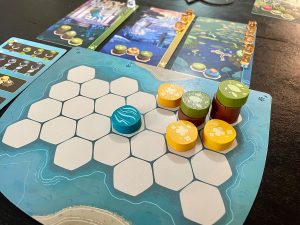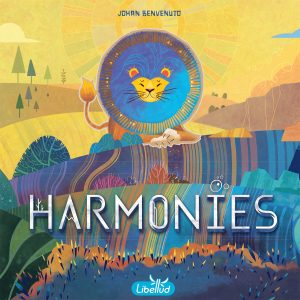 I rarely take a moment to look at the back of the game box. Typically, I’m too eager to dig into contents, punch cardboard, and organize components. But Harmonies, designed by Johan Benvenuto and illustrated by Maeva Da Silva, was so cleanly packaged that I had time to take it all in. Plus, I wanted to learn how the game was represented in a block of descriptive text to potential buyers.
I rarely take a moment to look at the back of the game box. Typically, I’m too eager to dig into contents, punch cardboard, and organize components. But Harmonies, designed by Johan Benvenuto and illustrated by Maeva Da Silva, was so cleanly packaged that I had time to take it all in. Plus, I wanted to learn how the game was represented in a block of descriptive text to potential buyers.
Harmonies does little to hide its simple charm as it describes itself in a single sentence: “Create a miniature world in which animals live in perfect harmony with nature!” I couldn’t have said it better myself.
Gameplay Overview:
For those familiar with Azul, the turn-by-turn process of Harmonies feels very similar. A central board is seeded with groupings of three tokens that represent different terrain. Players select a single grouping to add to their own personal board. These tokens must be placed immediately and there are different reasons to place tokens in certain arrangements. Play continues until tokens can no longer be drawn, or one player has two or fewer spaces left to fill.

So why are we placing these tokens? Harmonies provides direction via three avenues. First, players score points via common objectives for each terrain type. As an example, water tokens score based on how long of a river you can create. Trees and mountains score based on height and adjacency. Buildings score based on the surrounding diversity. There is an included player aid that provides each possible scoring option via these placements.
On a player’s turn, they have the option to take an animal card from a central market. This is the second avenue of direction and players have four slots available for these. Animal cards indicate the terrain arrangement that is necessary to take an animal cube from the card and add it to your tableau. Each card indicates how many animal cubes are added to it and each placed cube increases the card’s scoring potential.
The third avenue is an included module called Nature’s Spirit. Two of these cards are dealt to players before play, allowing them to select a spirit to add to a card slot. Once the spirit’s preferred arrangement is completed, they provide end-game points based on objectives such as landscape diversity or groupings.
Harmonies also includes double-sided player boards that allow for the option to build upon either land or water. The waterside changes scoring by adding a value to lands separated by water tokens – i.e. islands. The game also comes with a beat-your-own-score solo mode that is excellent for learning the intricacies of placement and scoring before playing with others.

Game Experience:
Harmonies has a vibe. The wonderful illustration on the box cover invites you in and this is enhanced by each animal card you encounter during play. As players select animal cards and terrain tokens, a small habitat begins to form in front of them. Due to token selection limitations, some animals may not find space in your landscape. No fear, as Harmonies provides scoring for the terrain you select regardless.

You must embrace the tactile nature of each round though. Harmonies is not a breezy game. Decisions about placement get more fraught over time as space is at a premium. Unless you are stacking trees, mountains, or buildings constantly, verticality succumbs to the sprawl of water and fields as players find the end game nearing. The available token options are filled with potential hindrances.
Decision space is plentiful but balanced by the direction of animal needs. Each card has a colored stripe on the side that provides a great visual cue for which habitat an animal is seeking. As such, gaining too many water animal cards is going to cause scarcity issues for placement, whereas a more balanced approach may find more homes for animals. Harmonies also provides further tension by making players stick with the animal cards chosen. Choose wisely.

My greatest accomplishments have been related to finding combinations among the available animal cards. Placing animals in an arrangement that can be expanded upon by then building vertically is quite satisfying. This not only has the potential to score you more terrain points but may also open more animal habitats if the cards are in your favor. And yet even through stellar moments such as this, end game scoring feels quite balanced and competitive.
Buy-in on this depends on the level of interaction you want at your gaming table. Beyond the token and card selection, there is little interaction between players. It is mostly multi-player solitaire with players comparing their completed puzzles in the end. That said, there’s not a whole lot to fault in the design as it seems to have carved its own niche in the Azul landscape. My only true gripe is the iconography for the terrain options below a building, which are hard to visualize, but easy to understand over time.
Final Thoughts:
Harmonies is great. It currently resides at the tail end of my top ten for the year and is well deserving of its Top 25 location on the family games list on BGG at the time of writing this review. It will climb further. My group has enjoyed their plays, my niece loved watching the habitats grow and helping me place animals, and my siblings furrowed their brows and growled at the decisions presented to them and the choice restrictions in both the market and on the central board. This is a simple design with well-considered elements of direction and tension. And Da Silva nailed the illustration to present a unique and inspired atmosphere.
Final Score: 4 stars – A pleasant package asking players to harmonize through tactical planning.
 Hits:
Hits:
• Card illustration
• Tableau table presence
• Card type indicator
Misses:
• Minimal player interaction
• Tri-base token icon
Source: Board Game Quest





